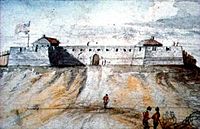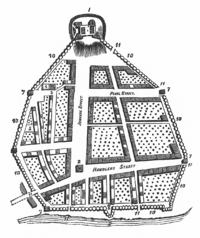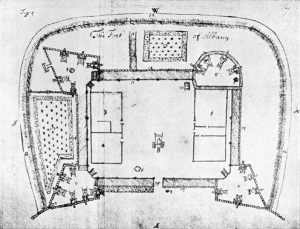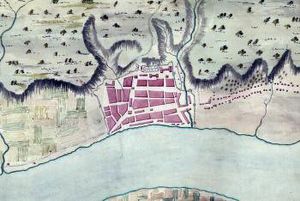Fort Frederick (Albany) facts for kids
Quick facts for kids Fort Frederick |
|
|---|---|
| Albany, New York | |

Fort Frederick in the 1700s as drawn by James Eights in the mid-1800s.
|
|

Map of Albany showing the stockade in 1695.
North is to right, fort at top. |
|
| Coordinates | 42°39′02″N 73°45′16″W / 42.65069°N 73.7545°W |
| Type | Fort |
| Site history | |
| Built | 1676 |
| Materials | Wooden stockade in 1676, masonry in 1703 |
| Demolished | 1790 |
| Garrison information | |
| Garrison | English army (after 1707 British) |
Fort Frederick was an important fort in Albany, New York from 1676 to 1789. It was built on top of State Street Hill, also known as Capitol Hill. This new fort took the place of an older, crumbling fort called Fort Orange, which was located along the Hudson River.
The fort was named after Frederick, Prince of Wales, who was the son of King George II. Sometimes, in old stories, it was called Fort Albany. Today, you can find several historical markers near where the fort once stood. These markers help us remember this important part of Albany's history.
Contents
History of Fort Frederick
After the English took control of New Netherland, the area around Albany became English territory. The Duke of York (who later became King James II) wanted a strong military presence in Albany. So, in 1676, Fort Frederick was built.
This new fort was meant to protect Albany from attacks, especially from the west. Unlike Fort Orange, which was mainly a trading post, Fort Frederick was a proper defense structure. It also showed the Dutch residents that the English were now in charge.
Building the Fort
Construction of Fort Frederick started in March and finished in June 1676. At first, it was a simple wooden fence, or stockade, surrounding two small buildings. Ensign Silvester Salisbury was the first person in charge of the fort.
The fort was located where Lodge and State streets meet today. When the Duke of York became King James II, the fort officially became property of the English Crown.
Changes and Upgrades
As people moved further west and north from Albany, the fort became less vital for defense. However, it was rebuilt between 1702 and 1735. This time, it was made of strong stone, not just wood. It had 21 cannons and a stockade that surrounded the entire village of Albany. This was part of a larger effort to improve forts across the province.
During the Seven Years' War (which Americans often call the French and Indian Wars), Fort Frederick housed many British soldiers. More buildings were added, like barracks (places for soldiers to sleep), storage areas, and a hospital.
Decline and Demolition
After the war, the fort started to fall apart. By the 1760s, people in Albany began taking stones and wood from the fort to use for their own buildings. In 1765, the city of Albany bought the fort from the government, which had already stopped using it.
During the American Revolution, what was left of the fort was used as a jail. It held people who were loyal to the British king. After the war, the fort was in the way of the city's growth. So, in 1789, Fort Frederick was taken down. The land was given to St. Peter's Episcopal Church. Today, part of the church's bell tower stands where a corner of the old fort used to be.
Historical Markers
To help people remember Fort Frederick, several historical markers have been placed in Albany.
One marker was put up during Albany's 200th birthday celebrations. It's on the west side of State and Eagle streets, near the New York State Capitol building.
In 1940, the New York State Education Department added another marker. This one talks about the fort's role in 1777, during the American Revolution. It's also in front of the Capitol building.
There's a third marker across the street from the others. You can find it in the middle of State Street, at the base of a clock pole. This marker shows a picture of Fort Frederick drawn by James Eights and a map of old Albany.
| Preceded by Fort Orange 1623–1676 |
Forts of Albany, New York Fort Frederick 1676–1789 |
Succeeded by None |




